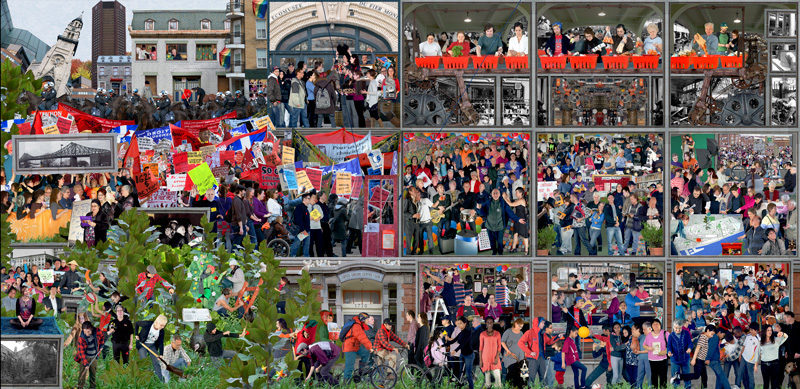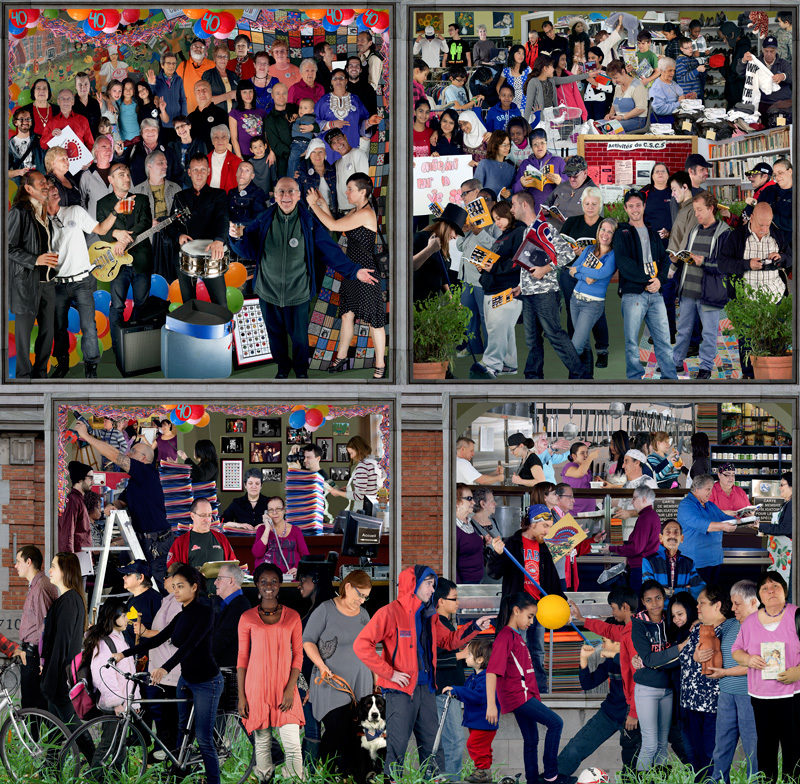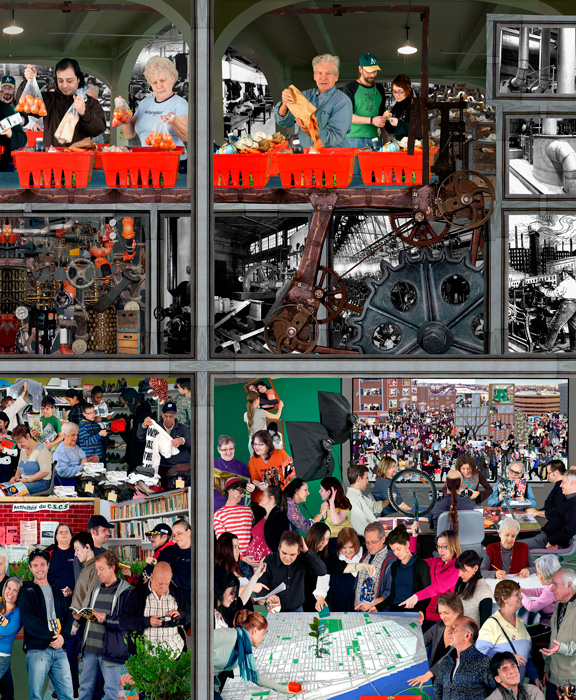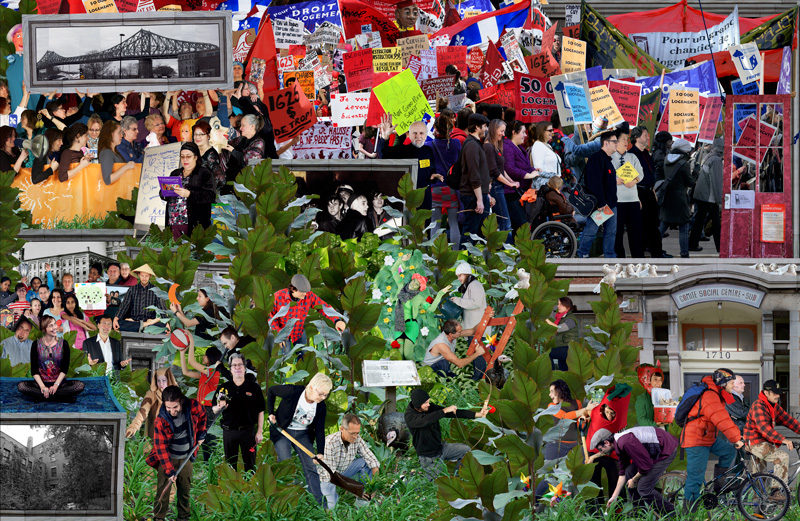[Spring-Summer 2013]
By Pierre Rannou
In addition to founding Diasol in 2002 and the Mexico–Quebec production collective FueralDFoco in 2007, Patrick Dionne and Miki Gingras, who have been working as a duo since 1999, have produced photographic projects in Nicaragua, Mexico, and Quebec. Far from fitting the image of picture chasers and big-time reporters, they seem, rather, to present themselves as pedagogues of photography, as their projects are intended both to document the contemporary world and to teach the rudiments of photography. For some of their projects, such as Humanidad and Mémoire, they have shown people how to make improvised pinhole cameras and become photographers in order to document their living environments; for other projects, they have produced portraits marked by their interest in political, social, and cultural issues. In 2009, they began a huge project aiming to raise the issue of the image of different Montreal neighbourhoods. This project, Identité, started in the heart of Montréal-Nord before moving on to Notre-Dame-de-Grâce and, after that, to Côte-des-Neiges. Two years later, the photographers turned to the Centre-Sud neighbourhood. In each neighbourhood, the photographers set out to produce a community portrait in the form of a fresco. In Centre-Sud, 350 residents responded to the invitation to contribute to construction of the image; they were delegated the responsibility of choosing their pose and the props with which they wanted to be portrayed. Beyond simply offering an opportunity to be singled out – as it was obvious that Dionne and Gingras intended to photograph individuals and not an anonymous mass – the project enabled participants to realize that they could step forward and make their uniqueness visible, and also reveal their relationship with other inhabitants of the neighbourhood. In addition to founding Diasol in 2002 and the Mexico–Quebec production collective FueralDFoco in 2007, Patrick Dionne and Miki Gingras, who have been working as a duo since 1999, have produced photographic projects in Nicaragua, Mexico, and Quebec. Far from fitting the image of picture chasers and big-time reporters, they seem, rather, to present themselves as pedagogues of photography, as their projects are intended both to document the contemporary world and to teach the rudiments of photography. For some of their projects, such as Humanidad and Mémoire, they have shown people how to make improvised pinhole cameras and become photographers in order to document their living environments; for other projects, they have produced portraits marked by their interest in political, social, and cultural issues. In 2009, they began a huge project aiming to raise the issue of the image of different Montreal neighbourhoods. This project, Identité, started in the heart of Montréal-Nord before moving on to Notre-Dame-de-Grâce and, after that, to Côte-des-Neiges. Two years later, the photographers turned to the Centre-Sud neighbourhood.
Beyond simply offering an opportunity to be singled out, the project enabled participants to realize that they could step forward and make their uniqueness visible, and also reveal their relationship with other inhabitants of the neighbourhood.
In each neighbourhood, the photographers set out to produce a community portrait in the form of a fresco. In Centre-Sud, 350 residents responded to the invitation to contribute to construction of the image; they were delegated the responsibility of choosing their pose and the props with which they wanted to be portrayed. Beyond simply offering an opportunity to be singled out – as it was obvious that Dionne and Gingras intended to photograph individuals and not an anonymous mass – the project enabled participants to realize that they could step forward and make their uniqueness visible, and also reveal their relationship with other inhabitants of the neighbourhood. Some opted for an individual setting and highlighted their passion for sports, such as Mario (cycling), Josué and Maxim (hockey), Okeya and Mahjabin (soccer), Tariq (karate), and Kelly, Alpha, and Rimsky (basketball), or their love of creativity, such as Anne (needlepoint), Nicole (embroidery), Pierre (painting), Laurent (design), Robert (dance), and Jeanne (music and singing). Others decided to have a group portrait, such as members of the Atelier des lettres, who were photographed reading their book, and the people of the Marché solidaire Frontenac and Rencontres Cuisines, who appear dressed up as foods. It isn’t insignificant that Dionne and Gingras decided to include in the fresco a session with the board of directors of Diasol. More than a simple nod to the organization, this section of the fresco may imply that they didn’t simply passively receive proposals but got directly involved in considering all of the suggestions that were submitted to them.
It’s not surprising to note that Dionne and Gingras chose to revive the spirit of composite photographs, a technique popular in the late nineteenth century, to make their photographic group portraits. In the early days of photography, exposure times were very long, and photographers adopted the technique of making composite photographs in order to reduce the risk of blurriness caused by subjects moving while the image was being captured. This simple procedure consisted of taking individual portraits against a painted or photographed backdrop. Some masters of the genre, such as Oscar Gustav Rejlander and Henry Peach Robinson, saw themselves on an artistic par with painters. Others, such as Montrealer William Notman, considered composite photography a simple and effective way to produce commissioned group portraits. Unlike their historical predecessors, Dionne and Gingras did not predetermine the composition of the group and made no sketches beforehand. In fact, the community portrait made in the Centre-Sud neighbourhood was not set against a single background. Rather, the idea was to convey the community’s different facets and highlight the dynamism of its organizations (Comité social Centre-Sud, Comité logement Ville-Marie, Éco musée du fier monde), while integrating its history (the factories of the former “faubourg à mélasse,” the firefighters’ strike of October 1974) and the great institutions established there (the Radio-Canada high-rise, the UQAM bell-tower). In analyzing the arrangement of each of these elements in the fresco, one can deduce that the photographers were letting it be understood that despite their imposing size, the major institutions have played only a marginal role in day-to-day life in the neighbourhood, as they are grouped at the edges of the image, whereas community organizations take centre stage in the composition.
By reviving the idea of the composite image, Dionne and Gingras also force us to become aware that constructing a community identity, like the production of their artwork, is an adventure full of rich human encounters. Thus, when they set up their improvised portrait studio in the premises of the Comité social Centre-Sud, Dionne and Gingras were choosing a spot that is both symbolic and essential, as it is a meetingplace for many neighbourhood residents and an important hub of community life. Similarly, the decision to exhibit the result in the main lobby of the Maison de la culture Frontenac was very perceptive, as it marked the desire to appropriate and occupy the pubic space and to point out the role that the people portrayed play in the community’s vitality. Stuck to the windows of the lobby, the brightly backlit photographic fresco was reminiscent of the gigantic displays used by ad agencies. Here, the radiance was being used not to sell yet more merchandise but to magnify the people and endow them with a sort of heroic character. For instance, members of the Sentier urbain and Écoquartier Sainte-Marie are portrayed as strong protectors of the environment. Similarly, the section of the work devoted to the community’s activist women, portrayed with their banner and bullhorn and holding up the Jacques-Cartier Bridge, goes far beyond simple figuration. Finally, the photographers’ connection with the “printemps érable” protesters seems to be a powerful political comment.
Dionne and Gingras twice used little scenes drawn from works by Diego Rivera, and I like to think that this indicates the vision that they would like their work to convey. Beyond a simple visual census of the area’s inhabitants, the community portrait is an invitation for people to take the time to see themselves living together, and to understand that what connects people often takes no more than seeing themselves as a community. In talking with the participants, Dionne and Gingras evoked not so much a record of the neighbourhood as a project, a vision that is built day by day. When one reads the stories and explanations of the people who posed, one grasps even better how they perceive themselves, their values, and their cultures.1 Far from the usual recourse to the “storytelling” aesthetic, the mechanism deployed by the photographers puts the participants centre stage and leaves it completely up to them to identify their community. This is why, it seems to me, Dionne and Gingras give an entirely new meaning to the notion of humanistic photography.
Translated by Käthe Röth
Since 1999, Patrick Dionne and Miki Gingras have been jointly creating photographic works that present social realities. They execute their projects in Quebec and Latin America. They received an award in Medellin, Colombia, for Humanidad, les enfants travailleurs du Nicaragua during the 18th Latin American Photo Competition. Since 2009, they have been making photographic murals on the theme of identity with residents of different areas of Montreal. They have had many exhibitions in Quebec, Canada, and Latin America. They live and work in Montreal.http://patmiki.blogspot.ca
Pierre Rannou is an art critic and art historian who works as an exhibition curator. He has published essays in collected works and magazines and written several exhibition catalogues. He teaches in the Film and Communications Department and the Art History Department at Collège Édouard-Montpetit.






